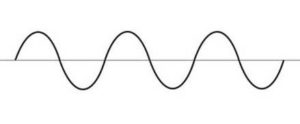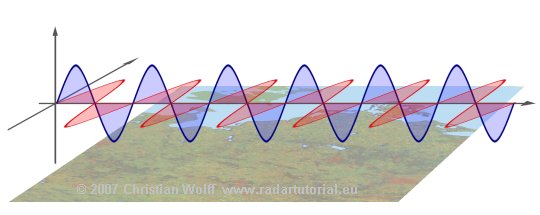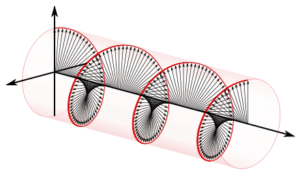This is a typical antenna for a cellular booster system. Placed outside at a height 15 feet above the indoor antenna, it forms a critical part of the booster. This particular antenna is fairly directional and is used when you know that you are a long distance from a single tower. If you know you have the ability to see more than one tower, an omnidirectional antenna might be a better choice.
This antenna slices into the air with a tall silhouette. Compare it with a TV antenna, which is wide and flat:

You might ask yourself why this is. After all, they are both antenna and actually the frequencies they receive are even pretty similar. You would think they would look a little more alike.
There’s a good reason they don’t.
When people think of broadcast signals, you kind of them going out in a generally circular way like this:

That’s kind of true, but broadcast signals are actually more like a sine wave. If you could see them they would look more like this:

It’s possible to think of radio transmissions as sort of “flat.” Most signals either fall on a horizontal plane or a vertical one. Here’s a graphic that tries to show the difference. It’s the best one I could find.

See how the blue signals travel up and down while the red ones travel left to right? We call that polarization and it’s done on purpose. TV signals are horizontally polarized. Cell signals are vertically polarized. Signals are polarized so that different kinds of signals can exist in the same parts of the broadcast spectrum with minimal interference. Cell signals exist right now in the 700MHz range, with TV signals going up (for now) to 698MHz. Polarizing them differently makes it possible for the two strong sets of signals to reach the antennas they need to reach.
Signals that are horizontally polarized need an antenna that’s horizontally aligned. (In other words, flat.) Signals that are vertically polarized need an antenna that is vertically aligned (in other words, tall.) That accounts for the difference between the way the antennas are mounted.
There is another form of polarization as well: circular polarization. In a circularly polarized signal, the signal travels like corkscrew pasta through the air. Here’s a graphic I found to illustrate it:

Circular polarization is most helpful when you’re trying to aim at multiple sources that are very far away. With circular polarization, if your antenna is a little off axis it still works, far better than it would with horizontal or vertical polarization. That makes it perfect for satellite dishes. However, circular polarization takes more energy than horizontal or vertical polarization so it does not make sense to use it where it’s not needed.
Whether you want an antenna for cellular, satellite, Wi-Fi, or over-the-air TV, you’ll find the best selection and prices when you shop at Solid Signal. If you need one-on-one advice, call us! We’re here during East Coast business hours at 888-233-7563. If it’s after hours, no problem! Fill out the form below and we’ll get right back to you!
The post Why are cellular antennas… sideways? appeared first on The Solid Signal Blog.
Continue reading...
It’s … sideways
This antenna slices into the air with a tall silhouette. Compare it with a TV antenna, which is wide and flat:

You might ask yourself why this is. After all, they are both antenna and actually the frequencies they receive are even pretty similar. You would think they would look a little more alike.
There’s a good reason they don’t.
Polarization
When people think of broadcast signals, you kind of them going out in a generally circular way like this:

That’s kind of true, but broadcast signals are actually more like a sine wave. If you could see them they would look more like this:

It’s possible to think of radio transmissions as sort of “flat.” Most signals either fall on a horizontal plane or a vertical one. Here’s a graphic that tries to show the difference. It’s the best one I could find.

See how the blue signals travel up and down while the red ones travel left to right? We call that polarization and it’s done on purpose. TV signals are horizontally polarized. Cell signals are vertically polarized. Signals are polarized so that different kinds of signals can exist in the same parts of the broadcast spectrum with minimal interference. Cell signals exist right now in the 700MHz range, with TV signals going up (for now) to 698MHz. Polarizing them differently makes it possible for the two strong sets of signals to reach the antennas they need to reach.
Pointing the antenna correctly
Signals that are horizontally polarized need an antenna that’s horizontally aligned. (In other words, flat.) Signals that are vertically polarized need an antenna that is vertically aligned (in other words, tall.) That accounts for the difference between the way the antennas are mounted.
Circular polarization?
There is another form of polarization as well: circular polarization. In a circularly polarized signal, the signal travels like corkscrew pasta through the air. Here’s a graphic I found to illustrate it:

Circular polarization is most helpful when you’re trying to aim at multiple sources that are very far away. With circular polarization, if your antenna is a little off axis it still works, far better than it would with horizontal or vertical polarization. That makes it perfect for satellite dishes. However, circular polarization takes more energy than horizontal or vertical polarization so it does not make sense to use it where it’s not needed.
Need help choosing an antenna?
Whether you want an antenna for cellular, satellite, Wi-Fi, or over-the-air TV, you’ll find the best selection and prices when you shop at Solid Signal. If you need one-on-one advice, call us! We’re here during East Coast business hours at 888-233-7563. If it’s after hours, no problem! Fill out the form below and we’ll get right back to you!
The post Why are cellular antennas… sideways? appeared first on The Solid Signal Blog.
Continue reading...

